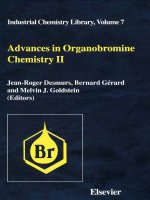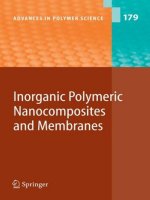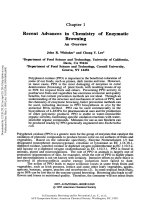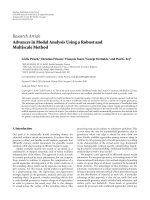Sykes a g advances in INORGANIC CHEMISTRY
Bạn đang xem bản rút gọn của tài liệu. Xem và tải ngay bản đầy đủ của tài liệu tại đây (6.07 MB, 382 trang )
ADVISORY BOARD
1. Bertini
Universite degli Studi di Firenze
Florence, Italy
A. H. Cowley, FRS
University of Texas
Austin, Texas
H. B. Gray
California Institute of Technology
Pasadena, California
M. L. H. Green, FRS
D. M. P. Mingos, FRS
Imperial College of Science,
Technology, and Medicine
London, United Kingdom
J. Reedijk
Leiden University
Leiden, The Netherlands
A. M. Sargeson, FRS
The Australian National University
Canberra, Australia
University of Oxford
Oxford, United Kingdom
Y. Sasaki
0. Kahn
Hokkaido University
Sapporo, Japan
lnstitut de Chimie de la Matiere
Condensee de Bordeaux
Pessac, France
Andre E. Merbach
lnstitut de Chimie
Minerale et Analytique
Universitb de Lausanne
Lausanne, Switzerland
D. F. Shriver
Northwestern University
Evanston, Illinois
W. Wieghardt
Ruhr-Universitat Bochum
Bochum, Germany
Advances in
INORGANIC CHEMISTRY
EDITED BY
A. G. Sykes
Department of Chemistry
The University of Newcastle
Newcastle upon Tyne
United Kingdom
VOLUME 44
@
ACADEMIC PRESS
San Diego London Boston
New York Sydney Tokyo Toronto
This book is printed on acid-free paper.
@
Copyright 0 1997 by ACADEMIC PRESS
All Rights Reserved.
No part of this publication may be reproduced or transmitted in any form or by any
means, electronic or mechanical, including photocopy. recording, or any information
storage and retrieval system, without permission in writing from the publisher.
Academic Press, Inc.
525 B Street. Suite 1900, San Diego, California 92101-4495. USA
http://www .apnet.com
Academic Press Limited
24-28 Oval Road, London NWI 7DX, UK
http://www .hbuk.co.uk/ap/
International Standard Serial Number: 0898-8838
International Standard Book Number: 0- 12-023644-3
PRINTED IN THE UNITED STATES OF AMERICA
9 6 9 7 9 8 9 9 0 0 0 1 B C 9 8 7 6 5 4 3 2 1
ADVANCES IN INORGANIC CHEMISTRY, VOL. 44
ORGANOMETALLIC COMPLEXES OF FULLERENES
ADAM H. H. STEPHENS and MALCOLM L. H. GREEN
Inorganic Chemistry Laboratory, University of Oxford, Oxford OX1 3QR, United Kingdom
I. Introduction
11.
111.
IV.
V.
VI.
VII.
A. Aim and Scope
B. Relevant Physical Properties of Fullerenes
C. Chemical Properties of Fullerenes
D. Classes of Organometallic Fullerene Adducts
Synthesis
Characterization
A. General Points
B. 13C NMR Spectroscopy
C. Vibrational Spectroscopy
D. UV-vis Spectroscopy
E. Electrochemical Studies
F. Other Techniques
Structure
A. n-Bonded Complexes
B. u-Bonded Complexes
Effects on Bonding of Metal Complexation
Physical Properties and Chemical Reactivity
A. Reactions of T Complexes
B. Reactions of u Complexes
Conclusion
References
I. Introduction
A. AIMAND SCOPE
The solid-state and organic chemistries of fullerenes are currently
active areas of research with possible applications, for instance, in the
field of superconductivity (1 ). As illustrated in Fig. 1,more than 3000
papers now have appeared in refereed journals (2).Several excellent
reviews summarizing physical (3),solid-state (41, and organic chemisI
Copyright 63 1997 by Academic Prese. Inc.
All righta of reproduction in any form reaewed.
2
STEPHENS AND GREEN
%
1
0.5
01989 1990 1991 1992 1993 1994
Year
FIG.1. Log,, of the number of C6,-relatedpapers published 1989-1994. {As determined
by an ACS Chemical Abstracts search on footballen (Cw),registry number 199 685-96-8].}
try ( 5 ) have been published. In contrast, organometallic chemistry
remains relatively unexplored (6,7).
This review describes the preparation, characterization, and properties of all nonpolymeric complexes that contain a metal CT- or 7r-bound
to a fullerene. In addition, for the sake of completeness, a number of
adducts where the metal is one bond removed from the fullerene also
are included. The article does not cover the essentially ionic fullerides
M,C, ( 4 ) or the endohedral metallofullerenes M,C, (81, which have
been reviewed previously. The extended fullerenes, or so-called carbon
nanotubes, which have hollow centers and can be filled with metal
salts, also are not discussed. The majority of complexes involve .rr-bonds
and, apart from alkyl lithium fullerides, the potentially useful synthetic
area of (+ complexes has not been explored. Table I shows the occurrence
of metal-bound adducts across the periodic table.
B. RELEVANT
PHYSICAL PROPERTIES OF FULLERENES
All fullerenes (C,)are composed of sp2hybridized carbon atoms forming a 3-D network of fused (n - 20Y2 six-membered and 12 five-membered rings. As enshrined in the Isolated Pentagon Rule (IPR), so far,
none of the structures isolated have two pentagons fused together. The
curvature of the cage results in some strain, and the three angles
around a carbon atom sum to 348" instead of the ideal value of 360"
for (260.The [6,61 fusions have most double-bond character and are
invariably where complexation occurs. For C6,there are 30 such equivalent double bonds. Although all fullerenes comprise alternating single
and double CC bonds, there is little 7r-electron delocalization between
the latter. As a result, fullerenes are more reactive than might be
expected and behave like giant closed-cage alkenes rather than super arenes.
ORGANOMETALLIC COMPLEXES OF FULLERENES
3
TABLE I
OCCURRENCE OF
FULLYCHARACTERIZED METAL-BOUND FULLERENE
COMPLEXES
The MO scheme for C6,, illustrated in Fig. 2, consists of a fivefold
degenerate strongly bonding HOMO ( H , ) and an essentially nonbonding LUMO ( T l J . The low-lying nature of the triply degenerate
LUMO means that it is very easy to populate. In both solution and
the solid state, it has been possible to prepare the anions C& (n =
1-6) (4,9).C,, has a large electron affinity (EA)= 2.65 eV, comparable
with other electron-withdrawing alkenes such as TCNE (EA= 2.88
hl,+g,
++-I-+++++*
%++-I-+
t2u
-Ih1s++
4tlu
++
++
++
++
ak
FIG.2. The partial MO diagram of Ce0.
4
STEPHENS AND GREEN
eV), and this strongly influences its chemical behavior. Thus, not
only does c 6 0 react readily with nucleophiles and radicals, but it is
also a relatively strong oxidizing agent and has been termed a
radical sponge. For the anions in the solid state there is sufficient
overlap between adjacent MOs that a band structure can develop,
with a band gap estimated to be ~ 1 . 7eV for an fcc lattice. Its
partial occupancy can result in interesting electrical and magnetic
properties such as superconductivity.
The low-lying nature of the HOMO of c 6 0 (1st ionization potential = 7.6 eV) means that its reducing behavior is very limited. However, electrochemical studies have shown that both c 6 0 and C 7 0 can be
reversibly oxidized to the monocations, at -+1.26 V vs Fc/Fc+ (10).
The small HOMO-LUMO band gap and presence of other close-inenergy MOs results in fullerenes being easily polarized. They all give
very intense Raman scattering lines and have relatively large x values
useful for NLO applications (11). Indeed, Cs0 is one of the best materials
known to date for optical limiting.
The MO scheme for the higher fullerenes is similar; for example, C 7 0
has a triply degenerate essentially nonbonding LUMO. Anions up to
C& have been made in both solution and the solid state, although the
latter do not show superconducting properties.
Table I1 lists some of the physical properties of c 6 0 and C,o.
TABLE I1
SUMMARY
OF PHYSICAL
PROPERTIESOF C, AND CT0
Property
Color
Density
First EA
First IP
Sublimation Point
AHB
Dimensions
Solubility
c,
Films are mustard. Bulk solid
is brown. Solutions are generally purple.
1.76 g cm-3
2.65 eV
7.54 ? 0.04 eV
-600°C
2327 ? 17 kJ mol-'
Diameter 7.1 A.
1.45 A ((3-0. 1.39 6 (CEO.
Soluble in CS2, aromatics,
and low-MW paraffins. Insoluble in ethers, H20, and
NHB.
c70
Films and bulk solid are
brown. Solutions are deep
red.
1.69 g cm-3
-2.69 eV
-7.6 It 0.2 eV
-650°C
2555 2 12 kJ mol-I
Diameter 7.8 by 6.9 A.
1.46 A ((2-0. 1.37 A (C=C).
Similar to but often slightly
higher than that of C, .
5
ORGANOMETALLIC COMPLEXES OF FULLERENES
c. CHEMICAL PROPERTIES OF FULLERENES
The chemistry of all fullerenes is dominated by their ability to
react as poorly conjugated and electron-deficient 27r alkenes; they
show very few properties typical of dienes or arenes (5).In addition,
because of the high cage stability, they never undergo substitutions.
Ce0 shows behavior similar to that of a monosubstituted alkene such
as vinyl chloride or acrylate. All fullerenes readily add to electronrich species such as nucleophiles, bases, radicals, or reducing agents.
They are, for example, perfect dienophiles for Dieles-Alder reactions.
The types of reactions undergone by fullerenes are illustrated in
Scheme 1.
It is a considerable challenge to isolate a pure adduct. One of the
unique features of fullerene chemistry is the large number of products
that sometimes result from addition of even one mole eqivalent of
reagent. Owing to its relatively high abundance, most fully characterized complexes are for Cso,but the behavior of higher fullerenes is
broadly similar. The availability of only small amounts of higher fullerenes, coupled with the inequivalency of some of the double bonds,
introduces additional complications.
Cy cloaddition
D
n-
D"+
Nucleophile
[Z]= q .
NR 0,s q .
e 4 ,or%
n>=2
Organic cyclonddurts
D = Electmn-rich
donor species
Fullerides pad chargetransfer adduets
Separate-group adduets
including morganomet.Uiee
SCHEME1. Schematic illustration of the general types of reactions undergone by Cm
(and higher fullerenes).
6
STEPHENS AND GREEN
D. CLASSES OF ORGANOMETALLIC FULLERENE
ADDUCTS
We now present an exhaustive survey of all the fully characterized
metal 7r or u complexes reported to date. The survey also includes
adducts where the metal is one bond removed from the fullerene, such
as C60020s02(4-ButC5H,N)2
and C60S2Fe2(C0)6.
Adducts in which the
metal is bound at a more distant site on the organic side chain are
not discussed.
In contrast to the great variety of known organic adducts, there is
a relative paucity of metal-containing fullerene complexes. Tables I11
and IV list (in yearly order of appearance in the literature) all the fully
characterized 7~ (6, 7) and many of the known u complexes.
For some of the complexes listed, analogous adducts are also quoted
in the paper, but the spectroscopic evidence for them is much less. For
instance, in addition to the listed complexes [Mo~q-C5H4Bu")z(~2-C60)l,
[ o ~ & c o ) l l ( ~ 2 - cand
~ ~ )[Pt(P(OPh)3)2(~2-C60)l,
1,
the compounds [Mo(q~ 5 ~ 5 ~ z ~ (22);
~ z [Os,(CO),o(L)(~2-C,,)1
- ~ 6 0 ~ ~
(L = MeCN or PPh,) and
[OS,(CO),(PP~,)~(~~-C~~)~
(34);and [C60{M(P(OR)3),),l(M = Pt, Pd or
Ni; R = Ph, Bu, or Et; n = 1or 2) (37)also have all been prepared and
partly characterized. The reaction of C,, with Pd,(dba), or Pt(dba), has
been reported t o give brown amorphous solids C,OM,, (M = Pd, n =
1-3; M = Pt, n = 1-2) (25,31,40),in which the value of n was found
t o vary depending on temperature and ratio of reactants. Although no
proof of the structure was presented, it was assumed to consist of a
3-D 0 - M polymer. Reaction of c 6 0 anions with FeC1, produced an
amorphous solid that is claimed to be C6oFe (41).
The gas-phase reaction of CS0with various metal ions has been monitored by mass spectrometry and reported to give MC,', [M = V, VO,
Fe, Co, Ni, Cu, Rh, La, Ni(C,,) and Fe(CO),I (42, 43, 44, 45). The
in the positivepresence of a peak corresponding to [RU(C,M~,)(C~~)]+
ion FAB mass spectrum of [{Ru2(p-C1)(p-X)(q)-C,Me,),}(q2-,q2'-c60)]
(X = C1, H)was taken as evidence for the formation of an $-c60 bond
in the gaseous phase (35).
As for the 7r complexes, there are additional CT adducts that are only
partially characterized. The multiple addition analogues C6,{S2Fe2
(CO),}, (n = 2-3) (53) are known, and Wudl prepared c~o(H)(Li)by
reaction of c 6 0 with LiBHEt, (56).An organometallic radical, C&g',
was prepared and analyzed using matrix isolation and ESR techniques (57).
Although fulleride lithium and Grignard adducts have often been
used as synthetic intermediates, only C,,(But)(Li) has been isolated
pure and fully characterized. Many alkyl lithium fullerides, such as
7
ORGANOMETALLIC COMPLEXES OF FULLERENES
TABLE 111
FULLYCHARACTERIZED
T-BONDED
METAL-FULLERENE
COMPLEXES~
~~
X-ray
13C NMR
structure
data
References
Compound
J
J
J
J
J
J
J
J
J
J
J
J
J
C1, H)
J
J
J
J
J
J
12
12
13
14
15
16
17
18
19
20
21
22
22
22
23
22,24
25,17
26,27
28
29
30
31
32
33
34
35
36
37
38
39
a For some complexes, there are no I3C NMR or crystallographic structural data, but
there are sufficient other spectroscopic details, such as elemental analysis, 31Por 'H
NMR, IR, UV, and/or MS, to warrant their inclusion.
In these cases, other structurally related adducts are also mentioned in the references,
but with considerably less spectroscopic data quoted.
' bobPPhp = P ~ C H ~ O C ~ H ~ C H ~ P P ~ Z .
PR3 = PPh3, PEt3, PMe2Ph, PPh2Me, P(OMe)3or Idppe.
C,(Li)(C=CTMS) (58, 591, C60(Li)(PPh2BH,)(60), and Cso(Li)(Me)
(52)have been prepared and quenched in situ with the electrophiles
H' or R'. Grignards that were prepared and reacted in situ include
C6,(MgHal)(CH2SiMe2Y)(Y = H, Me, Ph, CH=CH2 and OPr') (611,
8
STEPHENS AND GREEN
TABLE IV
FULLY
CHARACTERIZED
U-BONDED
METAL-FULLERENE
COMPLEXES~
Compound
X-ray structure
13C NMR data
References
J
J
J
J
46,47
48
49
J
J
50
51
52
53
54
55
55
a For some complexes, there are no 13C NMR or crystallographic structural data, but
there are some other data, such as elemental analysis, 31Por 'H NMR, IR, UV, and/or
MS, to warrant their inclusion here.
* L is the optically active Sharpless cinchona alkaloid ligand.
Dis = CH(SiMe&.
C,(MgHal)(Et) (621, and C,,(MgHal)(Ph) (52). As is discussed in
Section V, the extent of covalent (T bonding between CEO and Li or
Mg is debatable, and there is much evidence for charge delocalization.
The adduct of Schwartz's reagent and Cm, C60{(Zr(7)-C$5)2C1)(H)}n
(n = 1-3), also has been described and reacted in situ with N-bromosuccinimide, rn-chloroperbenzoic acid, or HC1 (63, 64 ).
II. Synthesis
The most widely used method for the synthesis of n metal fullerene
adducts involves the standard procedure of displacement by the fullerene of a ligand that is weakly bound to the metal. The ligand may be
PPh,, an alkene, or even CO under favorable conditions (Scheme 2).
Also, reductive elimination of H2has been used.
The effective generation in situ or direct reaction of a coordinatively
unsaturated species with the fullerene has also been used [Eqs. (1)-(4)1.
In the first two reactions outlined, NaOH effectively eliminates HC1
from the precursor, and the latter then reacts with c60 [Eqs. (1)and
(2)l (32).
ORGANOMETALLIC COMPLEXES OF FULLERENES
9
Pd
@-
Mop
SCHEME2. Synthetic routes to some fullerene organometallics by displacement of
weakly bound ligands.
In the case of Vaska-type compounds, (Ir(CO)(PR3)2C1),
it has proved
possible to form different adducts by varying either the fullerene or
phosphine used [Eqs. (5)-(7)] (13, 14,28,29,33):
Use of an excess of metal precursor often produces a multimetallic
adduct (Scheme 3) (33,38):
10
STEPHENS AND GREEN
Photolysis also has been used as in the preparation of C60{Re(CO),},
[Eqs. (8) and (9)l (50, 53). Care must be taken to
and C60S2Fe2(C0)6
deoxygenate any solvents used, as the triplet excited c60 (3C60)
produced
reacts very readily with 02.
cr-Organometallics have all been prepared by the effective addition
of [MI-R into a fullerene double bond (Scheme 4).
Slow addition at low temperatures of -1.2 mole equivalent of RLi
is preferable, as this minimizes multiple additions. For the less reactive
(i.e., bulky) alkyl lithiums and for all Grignards (52),[Zr(q-C,H,),HClI
(63,641,and Bu,SnH (52),then an excess of nucleophile is necessary.
The reaction can be monitored by removing aliquots, quenching with
dilute acid, and using an HPLC to analyze for products. Changing the
solvent can have important consequences, and Nagashima found that
SCHEME4. Synthetic routes to some cr-fullerene organometallics.
ORGANOMETALLIC COMPLEXES OF FULLERENES
11
a reaction run in thf or toluene favored the formation of a mono- or
diadduct, respectively (611.
Two germanium-containing compounds were prepared using the
route analogous to the standard route for silylene derivatives [Eq.
(1011 (55):
R
R = CH(SiMe,),
@
+
As far as the practical work-up procedure is concerned, the adducts
possess many of the physical and chemical properties typical of airsensitive compounds. However, because all the adducts tenaciously
retain solvent molecules, which can prove troublesome in elemental
analyses and in 13C NMR, it is worth outlining a procedure, found
highly useful by the authors, which circumvents the problem:
1. A concentrated solution of the unique compound is prepared using
an appropriate solvent with the aid of sonication. Low-boiling-point
solvents are preferable.
2. A large excess (-x5-10 volume) of pentane is added and the
resulting precipitate allowed to settle. Sometimes it is necessary to
filter using either glass or Whatman 50 filter papers, as natural settling
takes too long. Ordinary Whatman 1filter paper allows through many
of the finer particles of product.
3. The precipitate is washed up to three times with pentane aided
by sonication for ~ 3 0 - periods,
s
which breaks down the particle size.
4. Finally, the solid is dried in uucuo for -4 hours.
III. Characterization
A. GENERALPOINTS
Fullerene compounds have been characterized by typical spectroscopic techniques including 13C NMR, IR, UV-vis, electrochemical
methods, mass spectrometry (MS), and X-ray diffraction. Each of these
methods is discussed here in relation to specific points arising from the
12
STEPHENS AND GREEN
presence of a fullerene moiety in the molecule. Any problems arising
from the characterization of the remainder of the molecule are discussed
as warranted.
It is first worth mentioning some general problems of fullerene characterization. Not only can a mixture of various multiple adducts result
from a given reaction, but also each of them may exist as a mixture
of regioisomers that can often only be separated by HPLC. In addition,
there is often a poor signal-to-noise ratio for many spectroscopic techniques owing to the use of only small amounts of relatively high molecular mass and low solubility.
B. 13C NMR SPECTROSCOPY
By far the most powerful tool for analysis of fullerene compounds is
solution 13CNMR spectroscopy, as the number, positions, and relative
intensities of resonances often provide unambiguous evidence for a
particular structure. The molecular point group of about 300 fullerene
compounds has been identified using 13C NMR spectroscopy.
However, obtaining an adequate signal-to-noise ratio is often problematic. In addition to the complications of instability, low solubility,
and 13C isotopic abundance, there are also difficulties associated with
the presence of only quaternary carbon atoms. Such carbon atoms have
long relaxation times, and polarization transfer or NOE enhancement
pulse sequences cannot be applied. Several groups of workers have
added relaxation reagents such as Cr(acac), in the hope of shortening
the T,relaxation times. However, no qualitative or quantitative information has been reported concerning their effectiveness, nor have any
13Clongitudinal T,relaxation times been quoted. For all the intensity
arguments that follow, it is assumed that the fullerene carbon atoms
do not relax at significantly different rates from each other. The solvent
of choice is most commonly an aromatic or THF, but CS2also has been
occasionally used.
Of the few cases of reported scalar couplings between c6, and a metal
moiety, the value was comparable with analogous metal-alkene molecules.
1 , Identification of the Point Group
By observing the number and relative intensity of 13Cresonances it
is possible to identify to which point group an adduct belongs. For Cs0,
with I,, symmetry, all 60 carbon atoms are equivalent, giving rise to
a single sharp line at 143.3 ppm in C,D6. Complex formation causes
a reduction in symmetry, and the fullerene carbon atoms become in-
13
ORGANOMETAUIC COMPLEXES OF FULLERENES
TABLE V
NUMBERAND INTENSITY OF 8(l3C)FULLERENE
RESONANCES
IN DIFFERENT
SYMMETRY
ENVIRONMENTS
Point
group
Total no. of
resonances
No. of sp2
resonances
No. of sp3
resonances
Example
Reference
a C, (11) refers to the mirror plane running through the C(sp3)-C(sp3) bond. C, (1)
refers to the mirror plane bisecting the C(sp3)-C(sp3) bond.
No fullerene organometallics have been made yet with the CIpoint group.
equivalent, with more peaks appearing for a lower symmetry. Table
V shows the expected number of peaks for various common point groups,
and Fig. 3 illustrates some relevant structures. Not all the resonances
have equal intensity, as some carbon atoms lie on a mirror plane.
W
FIG.3. Examples of some of the various symmetries possible for Cso complexes.
14
STEPHENS AND GREEN
Even for a given molecular formula, a number of structures are
possible. For instance in the cases of organic carbene or nitrene adducts,
addition can occur at the [6,61or [6,51ring junction of the fullerene, and
each gives rise to a different symmetry product (66). Organometallic
additions have been found to occur only at the thermodynamically more
favorable [6,61 junction. For C,, and the higher fullerenes, the [6,6]
bonds are no longer all equivalent, and mixtures of regioisomers are
possible, each often with a different point group.
For di- and higher adducts, the number of regioisomers resulting is
even larger. Only in a few cases, such as [C,,,{Pt(PEt3),},], have they
been successfully isolated and spectroscopically characterized (16).
2. Assignment of Individual Fullerene Resonances
The chemical shifts of the fullerene sp2 and sp3 carbon atoms are
typically in the regions 155-135 ppm and 80-50 ppm, respectively.
However, in cases where the latter carbon atoms are bound to a n
especially electronegative heteroatom, then they resonate at much
lower fields, e.g., for CsOO6(Csp3) = 91 ppm (67, 68).
Assignment of individual sp2 carbon atom resonances to particular
carbon atoms of the framework has proved very difficult. A full analysis
was reported for C,,020s02(4-ButC,H,N)2, achieved using 13C2-D INADEQUATE on a 13C-enriched sample (46). Green and co-workers
successfully assigned most of the resonances in [CO(NO)(PP~,),(~~-C,,)]
by 2-D EXSY (27).Nevertheless, through observation of scalar couplings to the heteroatom X, it occasionally has proved possible to identify the sp2 carbon atoms adjacent to the sp3 ones (henceforth referred
to as the C2 carbon atoms) (49, 52, 60, 69, 70). In all these cases, as
TABLE VI
NUMBER
OF c 2 FULLERENE
RESONANCESFOR DIFFERENT
SYMMETRIES
'The letters A, B, C, and D refer to different chemical environment for the C2 carbon atoms
relative to the central metal complexed double bond.
ORGANOMETALLIC COMPLEXES OF FULLERENES
15
well as for C,,020s02(4-ButC,H,N)2 and [ C O ( N O ) ( P P ~ , ) , ( ~ ~ -these
C~~)I,
sp2 carbon atoms resonate at uniquely low fields, typically >150 ppm.
This useful generality also can help with the structural identification
of other C,, monoadducts. Often it is difficult to deduce the point group
from analysis of all the peaks, as they are often overlapping or are lost
in the baseline (especially true of the sp3 carbon atoms). Use of this
generality means that the symmetry can be tentatively deduced just
from counting the number of C2 resonances present.
For simple organometallic monoadducts with the point groups C,, ,
C, or C,, there will be one, two, or four chemical environments for
the C2 carbon atoms, respectively, and a corresponding number of
especially low-field peaks in the 13C NMR spectrum. Some examples
are illustrated in Table VI and Fig. 4.
16
STEPHENS AND GREEN
Furthermore, this generality also holds for practically all organic
closed [6,5] or [6,61 and separate group monoadducts (46, 71, 72). It
also is useful in the analysis of mixtures and multiple adducts; indeed,
the dimetallic adduct [{Rez(PMe3)4H,}(q2-,r)2'-C60)1
has three types of
C2 carbon atoms and, as expected, three low-field signals appear in
the
NMR. Higher fullerene adducts also often show especially lowfield signals whose number seems to be consistent with the generality,
such as for the compound C,,(H)(Me) (52).
Although it generally has not proved possible to assign further fullerene carbon atoms, most organometallics and many organic adducts
also show one fullerene sp2 resonance that is a little separated to
high field from the rest. For instance, as shown in Fig. 4, these
occur at 136.2 ppm for [Fe(C0)4(q2-C60)]
and at 137.0 and 136.9 ppm
For both C60020s02(4-ButC,H,N)2and
for [Rh(NO)(PPh,)2(q2-C60)].
[CO(NO)(PPh3)2(q2-C80)1,
the corresponding high-field signals have been
assigned to one type of sp2 carbon atoms that are adjacent to the C2
ones, henceforth referred to as the C3 carbon atoms. Furthermore, just
as for C2 resonances, the number of C3 sites generally equals the
number of these slightly high-field signals.
SPECTROSCOPY
C. VIBRATIONAL
Excluding local-site and solid-state effects, c 6 0 has 174 degrees of
are IR active
vibrational freedom. Only four of these vibrations (T,,)
and occur at 526,577,1184, and 1429 cm-', with those above and below
900 cm-' expected to involve predominantly tangential and radial displacements, respectively (3, 73).All monoadducts also show diagnostically strong bands in these regions. However, the lower symmetry of
an adduct causes a loss in degeneracy of the T,,modes and often results
in the bands being either broad or split. For instance, the IR spectrum
of [Ta(q-CSHs)2(~2-C60)H],
shown in Fig. 5 , contains bands at 572, 562,
529, and 518 cm-', compared with just two for uncomplexed c60 at 576
and 526 cm-I. Similar behavior was observed for [os~(co)~~(r)2~c~
(34).Despite the reduction in symmetry, no additional bands have ever
been unambiguously assigned to internal fullerene active vibrations.
For multiple addition adducts, the severe disruption to the cage structure results in a markedly different spectrum.
The u(C0) stretch for metal carbonyls is a useful way of assessing
the relative electron-withdrawing power of fullerenes. For [M(COI4
(r)2-c60)]
(M = Fe or Ru) and [Ir(CO)(PR3)2(fullerene~Cll,
values of
u(C0) suggest that fullerenes are similar to monosubstituted alkenes
such as methyl acrylate or acrylonitrile. For instance, for [Ru(CO),
ORGANOMETALLIC COMPLEXES OF FULLERENES
700
600
17
500
Wavenumberdcm"
FIG.5. Part of the IR spectrum of [ T ~ ( ~ ) - C S H S ) ~ ( ~ ' - and
C ~ ~Cso
) H Iin Nujol mull.
(q2-C6O)] and [RU(CO)~(~~-CH~CHCN)],
the two highest v(C0)s are at
2125,2056,and 2123,2055 cm-', respectively (26,27).These conclusions are in consonance with other studies such as cyclic voltammetry
or NMR.
Raman spectroscopy has proved a valuable tool not only for discussions of bonding but also, more interestingly, for structural elucidation.
This is because intense Raman scattering lines are generally observed
as a result of the relatively large polarizable nature of the fullerene
core. In a similar way to the IR spectrum, complexation causes loss
of degeneracy of the Raman active modes (8HI,and 2 A I g )and the
appearance of new previously silent modes. Both of these effects have
been observed for [M(PR3)2(q2-C60)]
(M = Ni, Pd, Pt; R = Ph, Et) and
[{M(PEt3)2}6(C60)l
(M = Ni, Pd, Pt) (17).Indeed the fivefold degenerate
mode at 772 cm-' (HI&
in c 6 0 is split into the expected five components
for the C,, complex [Pt(PPh3)2(q2-C60)].
Similar results have been found
in the surface-enhanced Raman spectrum of [Ir(q6-CgH7)(CO)(q2-C60)1
(74).Metal complexation causes a slight weakening of the bonds, as a
result of 7~ back-donation into the fullerene n* MOs, and a concomitant
shift to lower frequencies is observed.
18
STEPHENS AND GREEN
There are few IR and Raman studies of the higher fullerene adducts,
but the conclusions drawn are similar (52).
D. UV-VISSPECTROSCOPY
On complexation, the fullerene structure is not significantly altered
electronically and as a result the spectrum is similar to the unbound
form. In the case of c60,the following features are common to both the
free ligand and to all its monoadducts:
1. Two very intense bands at =220 nm, -255 nm.
2. One moderately intense band at =330 nm.
3. A broad, featureless weaker band between 450 and 600 nm.
Figure 6 shows the UV-vis spectra of c60 and [RU(C0)4(~2-C60)].
By reference to the MO scheme in Fig. 2, the bands at A < 400 nm
have been assigned to sharp and intense parity-allowed transitions
between occupied (bonding) and empty (antibonding) MOs. Such excitations include h,(HOMO)+ t,,(LUMO + 1)and Itg+ t,,(LUMO). Optical
transitions between the HOMO(h,) and LUMO(t,,), which are electric
dipole forbidden, occur via excitation of a vibronic state with appropriate u parity symmetry and account for the broad and low intensity
band at A > 400 nm.
4s00
t
1.100
I
3.375
ABS
2.250
1.125
190
367
545
WAVELENGTH lnm)
722
FIG.6. The UV-vis spectra of Cso and [Ru(C0)4(q2-Cso)lin CHzClz.
ORGANOMETALLIC COMPLEXES OF FULLERENES
19
In addition, many monoadducts including 7 ~ and
a-organometallics
exhibit a weak diagnostic peak at =430 nm. For [Ir(q5-C9H7)(CO)
(q2-c60)],spectrochemical UV-vis studies showed that this peak was
invariant upon reduction to the anion, consistent with it being an
intraligand transition that is only symmetry allowed in a reduced
symmetry complex (75). For organic compounds, its presence or absence
is a useful guide as to whether the structure is [6,6]-closed or [6,51open, respectively (76, 77). This is presumably because the fullerene
chromophore is less electronically perturbed in the latter. For multiple
adducts, the electronic structure of the cage is often sufficiently altered
that only some of the preceding features are observed (37, 78). Some
0 (79).
monoadducts also show a very weak peak at ~ 7 0 nm
UV-vis studies on C70 and higher fullerene adducts are scarce. However, the similarity in features between the free and bound fullerenes,
C Hallowed
~,
analogous structural
such as for C70 and C , , ( S ~ M ~ S ~ ) ~has
conclusions to be drawn (80, 81).
Assuming that no other strongly absorbing chromophores are present, then the organic c 6 0 adducts tend to be intensely red, whereas the
organometallic adducts tend to be intensely green or red. The extinction
coefficients ( E ) have values comparable to those of uncomplexed c60,
with the more intense color arising because of small shifts in the 450600 nm band.
Only the fulleride anions CEO ( n = 1-6) show broad (diagnostic)
peaks in the near-IR (NIR) spectrum (82,83).
E.
ELECTROCHEMICAL
STUDIES
All C,, adducts have low-lying LUMOs that can easily be populated
by electrochemical methods. For c60 itself, six reduction couples have
been observed by cyclic voltammetry (CV)or square-wave voltammetry
(SWV), and as many as four reduction couples have been found for
many organometallics (9,841. Most of the studies have been performed
in thf or acetonitrile at lower temperatures, which increases the size
of the potential window. Table VII lists the half-wave potentials for
some metal complexes, and Fig. 7 shows the cyclic voltammogram for
[Co(NO)(PPh,)2(q2-C,,)1.
The reduction couples are thought to be C,,-based rather than metalbased owing to their very similar, but slightly more negative, values
(84). This slight shift of --0.3 V indicates that the complexes are
harder to reduce and is due to perturbations in the electron affinity of
the fullerene cage arising from metal complexation. Shapley performed
spectrochemical IR studies on [Ir(q5-C,H,)(CO)(qz-c60)]and found only









